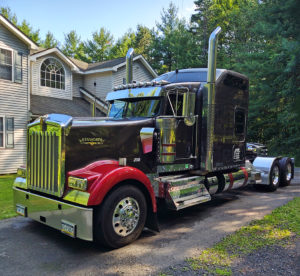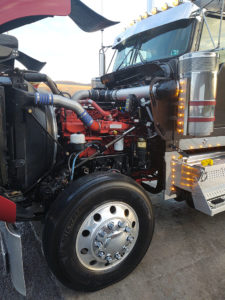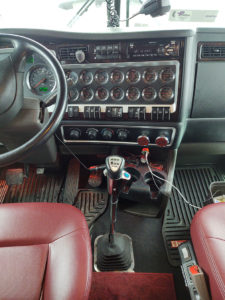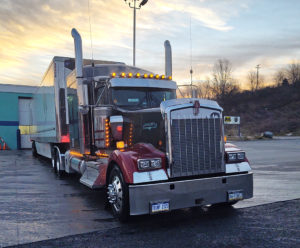There is a lot of confusion about what is the best differential gear ratio for pulling power, fuel mileage, and a good cruising speed. This article will pertain to over-the-road trucks, not heavy haul or vocational local trucking. To pick the right rear gears you must know the peak torque RPM of your engine, the ideal cruising RPM, and the speed you mostly drive on the interstate. Also, to fully understand gear ratios and what they represent, if your rear ends were geared at 3.73 (which if written properly would be 3.73:1), this means that for every 3.73 rotations of the drive shaft you get 1 rotation of the axle.
Today, almost all transmissions are double overdrive, which is a .73 final drive gear. The standard 13- and 18-speeds are all double overdrive, which means in the 13-speed, 11th gear is direct, 12th gear is .85, and 13th gear is .73. With the 18-speed, 16th gear is direct, 17th gear is .85, and 18th gear .73. Around 1990, Eaton did make a single overdrive 18-speed where 18th gear was .85, but this is a rare transmission (I happen to have one in my 1989 T-600 Kenworth).
This article is pertaining to most 1995 and newer 13- and 18-speed transmissions. If you have an Eaton 10-speed autoshift or a 10-speed manual and have 3.36, 3.55, or 3.73 rear gears, you still have a double overdrive transmission, but your 9th gear is direct, and 10th is .73. Unfortunately, this transmission has a big gap between 9th and 10th gear, so I am not a fan of 10th gear in a 10-speed. However, the 10-speed is still considered a double overdrive because of the .73 overdrive gear and because you cannot split the gears.
What is the most efficient gear for pulling and cruising? It is always the direct gear. Why? Because the power from the engine goes straight through the transmission to the differentials. When pulling in overdrive, the power coming into the transmission is diverted in the overdrive section of the transmission and consequently power is lost, heat is generated, and the transmission produces more noise. 1 to 1 (or direct gear) is always the best gear for fuel mileage, quietness, cooler temperatures in the transmission, and more pulling power. However, to run in direct gear, the rear gears must be either 2.64, 2.47, or 2.21 (there may even be a higher gear ratio than the 2.21).
The average speed today is 70 miles per hour. Engines want to be near their peak torque, so it’s up to you to call the manufacturer of your engine and ask them at what RPM is the peak torque and what RPM do they suggest the engine cruises at. Now you can determine what final gear ratio you need for your average driving and speed. Here is a list of speeds vs RPM running low pro 22.5 tires. With 2.64 rear gears: 62 mph = 1,390 RPM; 65 mph = 1,450 RPM; and 70 mph = 1,625 RPM. With 2.47 gears: 55 mph = 1,200 RPM; 60 mph = 1,280 RPM; and 65 mph = 1,375 RPM. With 3.08 gears (which is perfect for an X-15 Cummins in double overdrive in 13th or 18th gear): 65 mph = 1,265 RPM; 70 mph = 1,340 RPM; and 75 mph = 1,430 RPM.
The reason I’m telling you about the 3.08 is because Kenworth and Peterbilt do not understand running in direct gear and will usually not build the truck with a 2.21 or 2.47 gear ratio. So, you might be stuck running in overdrive, and in that case, the 3.08 is a better gear than the 3.36 or 3.25 that most of the PACCAR trucks on the lot are equipped with. Again, this is all predicated on low pro 22.5 tires.
If you have an older truck, 1995 up to about 2014, and you are thinking about changing the rear gears and like the RPMs the engine is currently turning at your cruising speed, than take your current gear ratio and subtract 91 from it – that will put you very close to the correct gear to run in direct gear. For example, 3.55 – 91 = 2.64 and 3.36 – 91 = 2.45, so you would install the 2.47 gear, and the 3.08 – 91 = 2.17, or the 2.21 gear ratio. The gears mentioned in this article are Eaton specs. Meritor has the equivalent gears, there is just a few numbers difference. I do not have the speed vs RPM of the 2.21 gear ratio, so you will have to go on Eaton’s website and find that yourself.
My good friend Mike Lane put it this way for people that do not understand that pulling in direct has more power than double overdrive. Think of a breaker bar… if it’s 36” long, you will be able to torque more than if the breaker bar is only 18” long. The 36” long bar is direct gear, while the 18” bar is double overdrive.
Pittsburgh Power is NOT a dealer for gears or transmissions, but we do change rear gears and transmissions. We purchase rebuilt differentials and transmissions from various rebuilders, and we also have a local rebuilder near us if you just want to rebuild your original unit. If you want to play around with different gear ratios and tire sizes, download the “Gear Calculator” on our website. You’ll need Microsoft Excel on your computer to make it work, but it’s a very useful tool.
Pictured is Don Griesmann’s 2018 Kenworth W900L. It’s been a great truck for Don, but he came across the opportunity to buy a ‘99 Pete that just had a body-off restoration, so he’s looking to sell this W900L. It’s a 283-inch wheelbase truck with a 605-hp Cummins X-15 that has been tuned to 730-hp by us. Power is delivered through an 18-speed with 3.25 rears. The truck features full lockers, disk brakes, and 22.5 low pro tires with low miles. Upgrades include JW Speaker headlights, a PDI intake manifold, an Espar bunk heater, and a Holland aluminum 5th wheel. And with only 271,000 miles, it’s barely broken in! Don also has all the maintenance records and oil samples. He’s asking $130K. If you’re interested, call him at (610) 390-7497.




